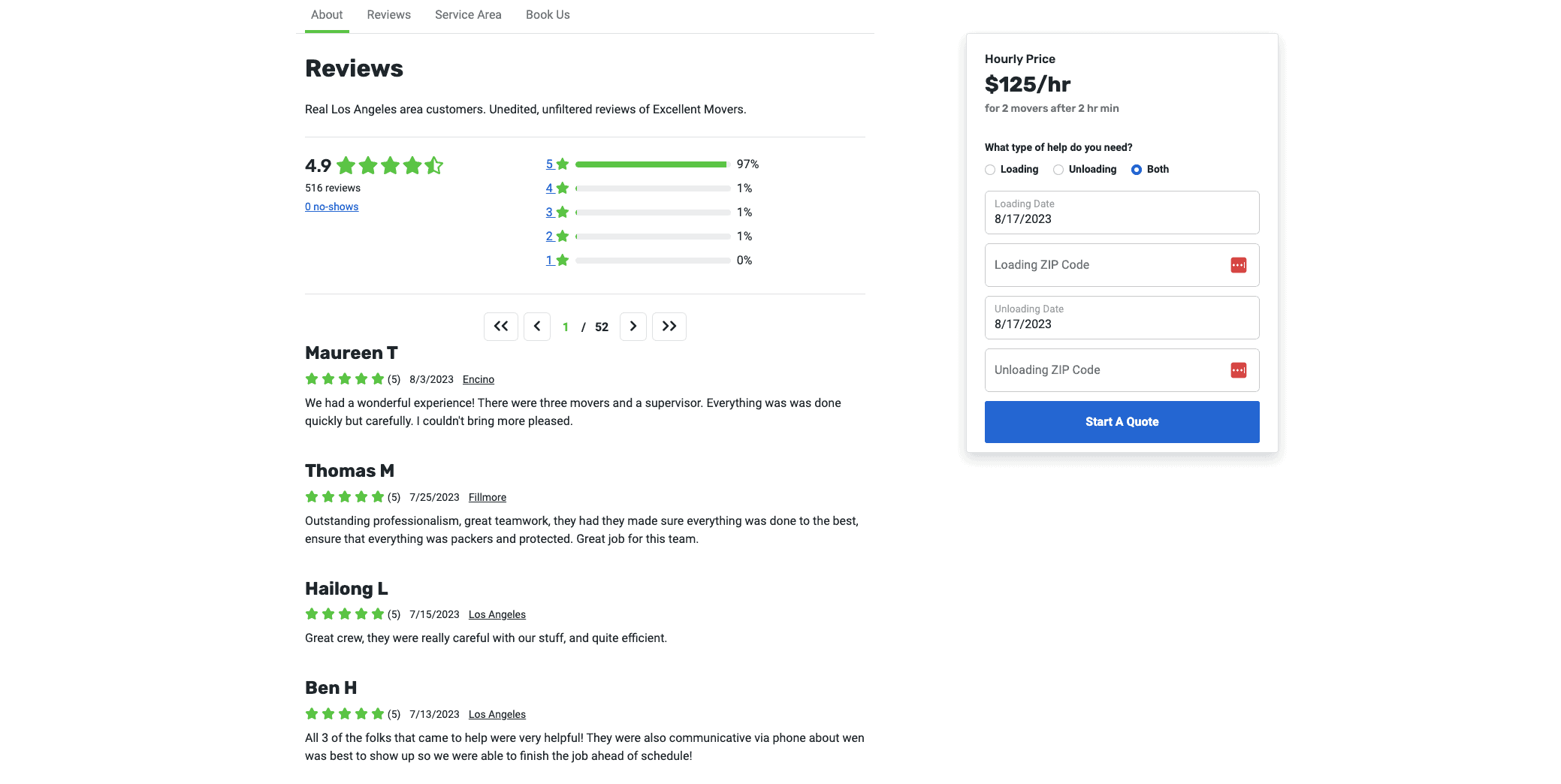If you’re a business with any kind of online presence, your customers are talking about you … somewhere. And you can bet people are reading it!
Customer reviews can make or break your business — especially for moving companies. In general, 93% of consumers read reviews before making a purchase. Meanwhile, 49% of consumers say they trust online reviews just as much as personal recommendations.
If your online profiles show a string of negative reviews — or even just comments from customers that were never acknowledged or addressed — you are almost certainly losing out on bookings. Once you understand how you can leverage them to your benefit, you’ll quickly come to embrace customer reviews, even if they’re negative! Here’s how.
Where Do Moving Customers Leave Reviews?

Aside from your website, there are a number of places where customers can leave reviews about their experience working with your company. You could have reviews out there that you never even knew about.
Here are some common sites that feature customer reviews:
- Google My Business: Google is often the first place people go when they are researching a company. By creating a Google My Business profile, you allow your customers to leave reviews directly on your Google listing.
- Yelp: Yelp collects business reviews for virtually all industries, including moving companies. (But no customer service!)
- Facebook: If your moving company has a Facebook business page, customers can leave reviews there. These reviews are visible to anyone who visits your page.
- Better Business Bureau (BBB): The BBB is a legacy source of business reviews, and they have a specific category for moving and storage companies.
- Angie’s List: Angie’s List is a well-known site where customers can leave reviews for all types of service providers, including movers.
- HomeAdvisor: HomeAdvisor is a platform where homeowners can find and vet contractors for all kinds of services, including moving services.
- HireAHelper: As the largest mover marketplace on the internet, there are over a quarter of a million mover reviews on HireAHelper. They handle nearly all customer communication and coordination for you, but you get to personally respond to any reviews left by customers if you want.
How Do You Improve Your Customer Reviews?
Yes, all businesses should encourage customers to leave reviews.
It’s important to respond to them in a thoughtful and respectful manner, regardless of whether they’re positive or negative. However, there are some steps you can take to improve the quality of reviews and increase the number of positive ones.
 Respond to ALL reviews
Respond to ALL reviews
Responding to reviews shows appreciation for the customer’s time and effort — not just to them, but to everyone reading.
And make sure it’s an original response — no matter what — and never copied and pasted! It conveys that your moving business values their input and is listening to their experiences and feedback. You will ultimately leverage these reviews to improve your business and increase revenue.
However, it’s crucial to handle your original responses with care. A poorly crafted or defensive response can severely damage your reputation. Ideally, responses to customer reviews should be professional, courteous, and aimed at resolving any issues.
Responding to positive reviews
Who doesn’t love a happy customer? But there are still some important things to remember:
- Yes, make sure you take the time to respond to positive reviews. And even though it’s a positive review, maintain a professional tone in your response.
- Be sure to personalize your responses by addressing the reviewer by name. This shows you value them as an individual and not just a customer number. It’s also important to express sincere thanks for the time the customer took to leave a review. You can say something like, “Thank you for taking the time to leave us such a fantastic review.”
- If the review includes specifics about what the customer liked, reinforce those elements in your response. For example, “We’re thrilled to hear that you loved our moving service, especially the part about…”
- Encourage the reviewer to return to your business, and that you appreciate recommendations to friends and family.
HireAHelper is a nationwide marketplace where you can compare and book local movers to help you pack, load and unload your moving truck or container.
Responding to negative reviews
Here’s the hard part of dealing with reviews … no matter how much time and effort you put into running your business the right way, there are bound to be a few dissatisfied customers. Maybe one of your movers accidentally chipped a table, or perhaps your customer was just having a bad day and decided to take it out on your review page.
Here’s what to do:
- Act quickly: Respond to negative feedback as soon as possible. A swift response shows that you care about customer satisfaction and are serious about resolving their concerns.
- Always begin by acknowledging the customer’s concerns and offering an apology for their experience. Even if you believe your business did nothing wrong, you can still express regret that they had a negative experience. Empathy can go a long way in diffusing a negative situation.
- It’s natural to feel defensive when you receive a negative review, but it’s crucial to address negative reviews constructively and empathetically. It can turn a dissatisfied customer into a satisfied one and show potential customers that you’re dedicated to resolving issues. (Remember that your response is public and will be seen by future customers!)
- Definitely don’t delete negative reviews — one study found that 62% of consumers say they won’t buy from a brand they think censors online reviews. (In other words, people are suspicious of 100% 5-star reviews, and for good reason!)
- If the customer has mentioned specific issues, quickly hone in on them in your response. This shows that you have carefully read their review and are responding to their particular situation. Then, propose a way to resolve the issue, whether it’s a partial refund, further conversation offline, or some other solution.
- Remember to thank them! Yes, even for negative reviews. The feedback can help you improve your business, and showing appreciation for that can help repair the relationship with the upset customer.
The Hidden Benefits of Customer Reviews
Reading your customers’ reviews is about more than feeling warm and fuzzy when they have something nice to say. There are a number of benefits of customer reviews for a moving business, whether positive or negative.
- Drastically improve sales: Maybe not a “hidden” benefit, exactly, but positive reviews will help seal the deal with future potential customers. The more positive reviews you accumulate, the more business you’ll likely book. Simple, right?
- SEO benefits: “SEO” stands for “search engine optimization”. Basically, search websites like Google, Bing and Yahoo consider customer reviews in their algorithms for what websites they show when people search for stuff. Having lots of reviews will help your business rank higher in result pages when people are searching for local moving companies. Huge!
- Customer engagement and retention: You want customers to engage with your brand, and reviews are one of the best ways to do this. Your efforts are not only appreciated, but they result in more brand recognition and ultimately, return business.
- Super direct feedback: Reviews provide honest feedback about your moving business, which you can use to identify areas of improvement.
- Credibility: Having reviews at all significantly boosts a business’s credibility and reputation. How many times have you Googled something just to check if it was a real thing?
- Customer knowledge: Reviews can also provide you with valuable insights into your customers’ preferences, needs and expectations. You may be surprised what areas continue to be brought up that maybe you deprioritized, or weren’t even aware about!
How To Encourage Customers To Leave Reviews
So how can you encourage your customers to leave reviews to boost your business marketing efforts? Here are some ideas:
- Just ask: Sometimes, the simplest way to get reviews is just to ask. You can do this at the end of a transaction, via email, or even on social media. Explain how much you appreciate customer feedback and how it helps your business.
- Make it super easy: Be sure the process for leaving a review as simple as possible. Provide direct links to your review profiles in emails or on your website. If the process is too complicated, customers will almost never leave you a review.
- Incentivize reviewers: Offer a small incentive to encourage customers to leave a review. Some people give small discounts, gift card giveaways, or things like that. Just don’t get carried away and seem like you’re attempting to purchase their review.
- Follow up: After you complete a move for a customer, follow up via email or text message to ask for a review. You can use this opportunity to thank them for their business and request their feedback. (It’s worth noting HireAHelper automates this for all your HireAHelper jobs, so your reviews will come in like clockwork.)
What To Do After You Get Reviews
So now you have plenty of customer reviews to work with. Good job! But what, exactly, can you do to use those reviews to boost your business after you get them?
- Share reviews on social media: Sharing positive reviews on all social media platforms can help spread the word about your great customer service or products.
- Highlight reviews on your website: Consider creating a dedicated “Testimonials” section on your website. This can be one of the first places prospective customers visit to determine if they want to book your movers (Don’t have a website? Setting up a free profile on mover marketplace websites is that much more important if you don’t have a nice one of your own!)
- Use in marketing materials: Positive customer reviews can be used in your marketing and promotional materials, whether it’s a brochure, email campaign, or online advertisements.
- Inform service development: Positive reviews can give you a sense of what you’re doing right, what customers appreciate most about your moving services, and what makes your business stand out. This information can be instrumental in developing new services or refining existing ones.
- Motivate your team: Positive customer reviews aren’t just a great tool for growing your business internally — they’re also helpful for motivating your team internally. Sharing positive reviews with your team can boost morale and show your team that their efforts are recognized and appreciated by customers.
Keep in mind that you should request permission from customers before publicly using their reviews, particularly if you’re using them in a broader marketing campaign or sharing them in a public space beyond the platform where they were originally posted.
On the surface, customer reviews might seem inconsequential or even be a bit of a nuisance. If your moving business is already doing well, you might not think it’s important to invest time into responding to customer reviews and fostering more of them.
However, ignoring reviews could mean leaving money on the table. Customers are going to review your business whether you engage with them or not, so you might as well take advantage of the opportunity to improve customer service, increase credibility, and drive more sales.


 Respond to ALL reviews
Respond to ALL reviews

